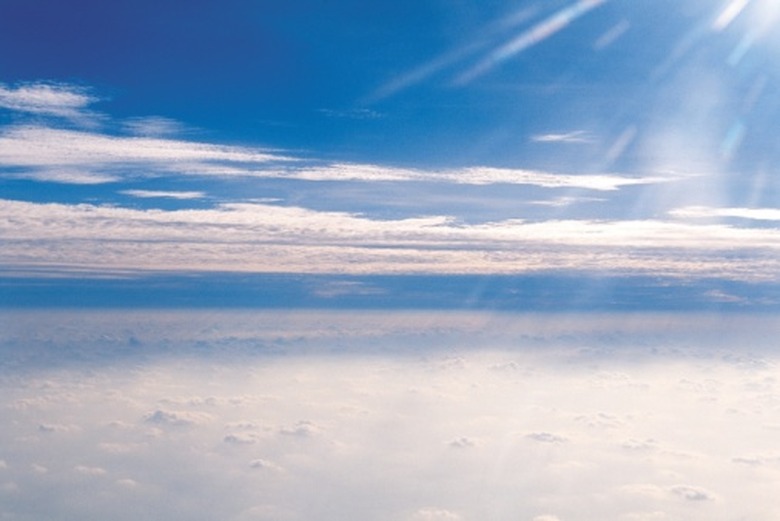Characteristics Of The Stratosphere
The layer of the atmosphere which is closest to the Earth, the troposphere, is where virtually all the weather and cloud action that help define our skies take place. Above it lies the second-lowest atmospheric layer: the stratosphere, whose lower boundary with the troposphere comes marked by the tropopause.
The stratosphere – named for its "stratified" layers of air that don't vertically mix much – plays a key role in buffering the biosphere from UV radiation thanks to its ozone layer, and also happens to be where you spend much of your flights in a commercial jet aircraft.
Basic Stratosphere Characteristics
Basic
Stratosphere Characteristics
While the height of the tropopause varies – it's higher over the equator than over the poles, and higher in summer than winter – the stratosphere roughly stretches between about 6 miles to 30 miles above sea level in the middle latitudes.
Temperatures remain fairly steady in the lowest part of the stratosphere, but then increase rapidly with increasing altitude up to the stratopause, the boundary – located about 30 miles in altitude – between the stratosphere and the mesosphere, the overlying atmospheric layer.
This temperature rise with altitude in the stratosphere – opposite the situation in the troposphere, where temperature drops the higher you go – is due to the presence of ozone, a form of oxygen molecule that heats up by absorbing ultraviolet radiation from solar energy. That keeps conditions on the Earth significantly more hospitable than they otherwise would be.
Stratosphere Composition
Stratosphere Composition
Besides the larger amount of ozone – and lower concentrations of water vapor, significantly – stratosphere composition resembles the troposphere's, dominated by nitrogen and oxygen with trace amounts of other gases such as argon.
The increase in temperature up the stratosphere discourages vertical movement and mixing of air, which makes this layer of atmosphere calm compared to the weather-roiled tropospheric realm below. This stability and low amount of turbulence as well as the lower air density at these altitudes, which allows aircraft to reach maximum flight efficiency, are why commercial jets usually cruise in the lower stratosphere.
Remarkably, some bacteria and other microbes waft about in the stratosphere: the highest-known lifeforms of our planetary system.
Stratospheric Clouds
Stratospheric
Clouds
The stratosphere is usually cloud-free on account of its extremely dry, warm air. However, in the winter at and near the poles, frigid temperatures in the lower and middle stratosphere can produce the beautiful upper-atmosphere clouds known as polar stratospheric clouds. Polar stratospheric clouds composed of ice crystals are also called nacreous or mother-of-pearl clouds because of their striking iridescence.
Another variety of polar stratospheric cloud contains droplets of nitric acid and water. These stratospheric clouds can decrease ozone by providing a surface for chemical reactions that convert chlorine into ozone-destroying free radicals and by removing stratospheric nitric acid, which reacts with chlorine to make it less destructive.
Polar stratospheric clouds, which typically form between about six and 15 miles in altitude, aren't the highest of our atmosphere's clouds: those would be noctilucent clouds, which form in the summertime mesosphere at heights of 50 miles or so.
Thunderstorms and Transient Luminous Events
Thunderstorms and Transient Luminous Events
Vigorous thunderclouds can actually intrude slightly into the lowest stratosphere in the form of so-called overshooting tops resulting from intense convection (the rising of warm air). The turbulence associated with such thunderstorms creates a localized zone of mixing between the troposphere and stratosphere.
The electrical fields caused by thunderheads, which of course create lightning within them and down to the Earth's surface, trigger colorful pulses of light in the upper atmosphere known as Transient Luminous Events (TLEs).
One kind of TLE, known as a blue jet, consists of a conical blue discharge that fires in the stratosphere from the field created by the positively charged cloud top of the thunderstorm and the negatively charged zone formed above it. Blue jets are thought to transport water vapor as well as nitric and nitrous oxides into the stratosphere and also locally decrease ozone concentrations there.
Another TLE, the red sprite, originates at altitudes above the stratosphere, but its "streamers" can propagate downward into this layer.
Cite This Article
MLA
Shaw, Ethan. "Characteristics Of The Stratosphere" sciencing.com, https://www.sciencing.com/characteristics-stratosphere-8374756/. 22 November 2019.
APA
Shaw, Ethan. (2019, November 22). Characteristics Of The Stratosphere. sciencing.com. Retrieved from https://www.sciencing.com/characteristics-stratosphere-8374756/
Chicago
Shaw, Ethan. Characteristics Of The Stratosphere last modified March 24, 2022. https://www.sciencing.com/characteristics-stratosphere-8374756/
